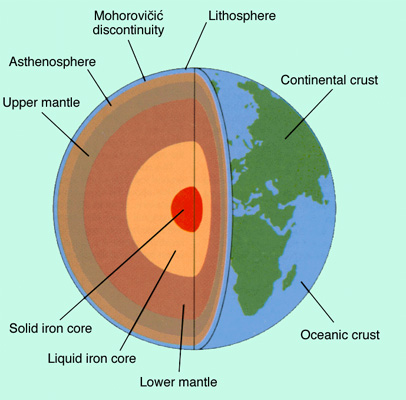Deepest borehole ever drilled
by
Most geotechs get involved with drilling holes into the ground in order to do tests in situ and to take samples to do various tests on them. Drilling holes into the ground is a common activity for us geotechs. We routinely decide how deep the hole should extend; of course, it all depends on the project.
So I asked,
- When and where was the deepest borehole drilled in the world?
- Who did it and why?
- What did they find?
- Who tried to beat them to it?
- What happened?
This was about the Mohorovicic discontinuity. Those geotechs in the soil dynamics/geotechnical earthquake engineering field know what it is. It is essentially the bottom of the earth's crust. The Earth's crust (the solidified, thin outer shell of the molten rock the Earth is) varies in thickness, 30 to 50 kilometers (20 to 30 miles). Take a look at this "cutout" view of our planet.

Mohorovicic may be a hard word to pronounce. Here is a WAV (sound) file for you; click to hear this Croatian word, the name of the geophysicist who discovered it.
Mohorovicic discontinuity, which puzzled the scientists for a long time—until one day they started saying why don't we just go there and take a look? That's how drilling a hole, a very deep hole, came to be discussed.
This quote from a recent Bill Bryson book contains all the answers.
In the 1960s...
Earth scientists decided to drill through the Earth's crust down to the Mohorovicic discontinuity (where upper mantle begins), and take a sample."The project became known as the Mohole and it was pretty well disastrous. The hope was to lower a drill through 14,400 feet (4.5 km) of Pacific Ocean water off through relatively thin crustal rock. Drilling from a ship in open waters is, in the words of one oceanographer, "like trying to drill a hole in the sidewalks of New York from top the Empire state Building using a strand of spagetti." Every attempt ended in failure. The deepest they penetrated was only about 600 feet (200 m). The Mohole became known as No Hole. In 1966, exasperated with ever-rising costs and no results, Congress killed the project.
Four years later, Soviet scientists decided to try their luck on dry land. They chose a spot on Russia's Kola peninsula, near the Finnish border, and set to work with the hope of drilling to fifteen kilometers. The work proved harder then expected, but the Soviets were commendingly persistent. When at last they gave up, nineteen years later, they had drilled to a depth of 12262 meters, or about 7.8 miles. ... the Kola hole had not cut even one-third of the way through the crust, we can hardly claim to have conquered the interior.
I highly recommend this book to you.
Quote from p. 214-5, Bill Bryson (2003) "A Short Story of Nearly Everything" Broadway Books. Broadway, a division of Random House, Inc.